June 17, 2016: 2016 CSIE|UM Symposium
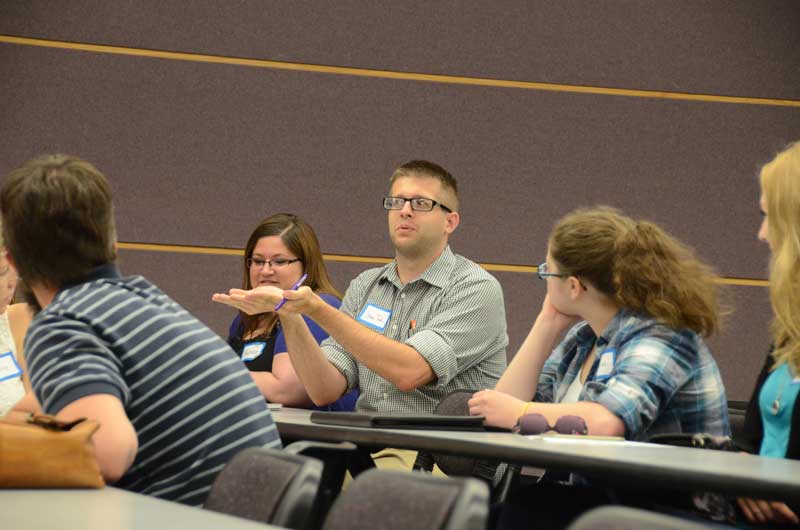 The second annual CSIE|UM Symposium was held on Friday, June 17, 2016. This event, as are the rest of our activities, was designed, organized, and carried out by the CSIE|UM organizing committee.
The second annual CSIE|UM Symposium was held on Friday, June 17, 2016. This event, as are the rest of our activities, was designed, organized, and carried out by the CSIE|UM organizing committee.
Continuing the theme last year’s Symposium, events for the day revolved around the challenges for teaching undergraduate laboratory courses.
We welcomed a total of 46 participants, including 15 colleagues who came to Ann Arbor from UM – Flint, Siena Heights University, Michigan State University, Eastern Michigan University, Kettering University, and Wayne State University.
Break-out Sessions
After gathering together for an overview of the day, we split into smaller groups for facilitated discussion of key questions related to undergraduate laboratory reform. Topics and facilitators are listed below:
- Can you innovate (in undergraduate labs) without it taking over your life? – Matt Beyersdorf
- Can an innovation outlast the innovator? – Rachel Barnard
- Should lab and lecture always be integrated? – Becky Matz
- As chemistry is increasingly interdisciplinary, what is the role and purpose of the traditional chemistry curriculum? – Alena Moon
- Why do labs exist? What value do they bring? Are there core skills and practices we expect students to learn in undergraduate labs? If so, what? – Meagan Hinze
- Can meaningful writing be incorporated into the undergraduate chemistry curriculum? – Carol Ann Pitcairn
Notes from the break-out discussion are available for viewing here:
https://docs.google.com/document/d/1ebdDiW3L6XCqQWdwJw2W06Obg3p5lBwaJMJpl8lbx4M/edit?usp=sharing
Reporting Out on Break-out Discussion
We reconvened from our break-out groups to hear from each discussion group. A central theme of many groups was the idea of critical thinking amongst undergraduates in laboratory and lecture settings. One participant asked, Shouldn’t lectures and not just labs involve critical thinking? Another participant asked the assessment question: What evidence would you accept as counting for critical thinking?
Lunch & Poster Session
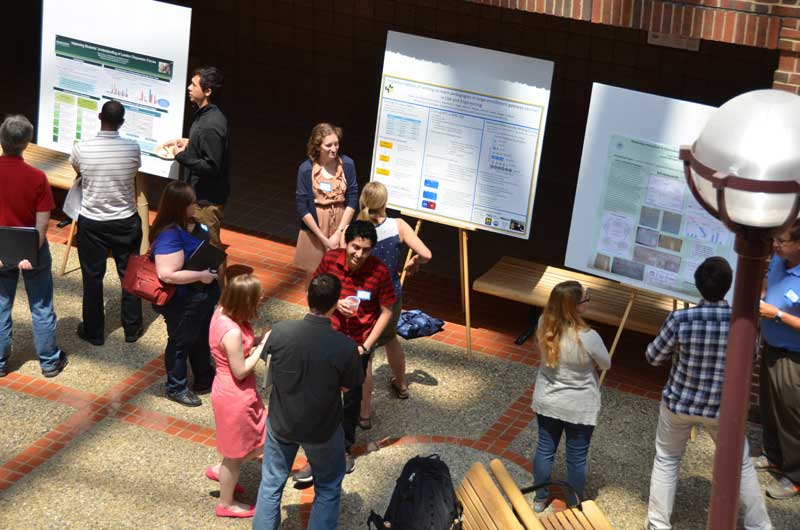 After time for networking over lunch, a group of 6 posters, including those from some of our off‑campus guests, were displayed in the lower Atrium. Conversations over the dessert were plentiful and animated.
After time for networking over lunch, a group of 6 posters, including those from some of our off‑campus guests, were displayed in the lower Atrium. Conversations over the dessert were plentiful and animated.
The list of poster can be found in the Symposium Program.
Hands-on Workshops
In the next session, four interactive workshops featured activities drawn from some active projects in the department.
(1) ORGANIC CHEMISTRY I LABORATORY
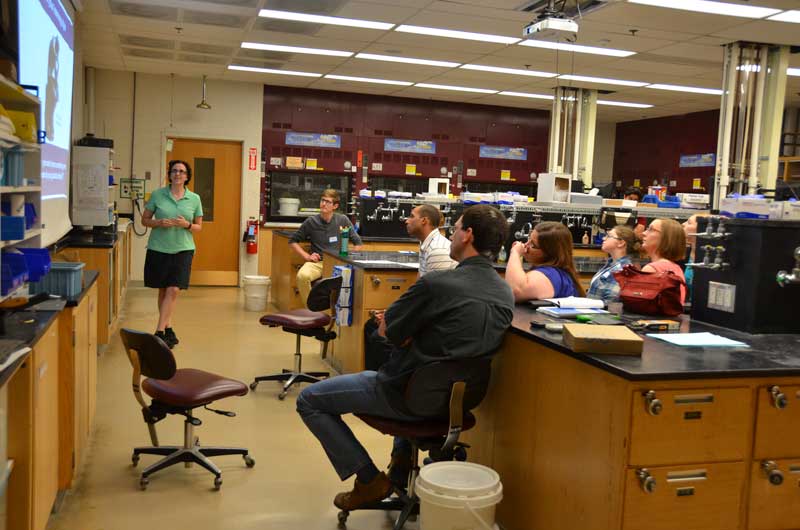 Professor Anne McNeil along with Michele Nelson (McNeil group) and Sameer Phadke (McNeil group) led an interactive example of how they have encouraged study collaboration in the organic chemistry I laboratory course. Participants engaged with jigsaw style activities to build up concepts related to one of the course modules. This collaborative approach to the laboratory encourages students to develop a unique scientific approach to solving a particular problem over the course of a three-week module with an emphasis on guided inquiry-based learning.
Professor Anne McNeil along with Michele Nelson (McNeil group) and Sameer Phadke (McNeil group) led an interactive example of how they have encouraged study collaboration in the organic chemistry I laboratory course. Participants engaged with jigsaw style activities to build up concepts related to one of the course modules. This collaborative approach to the laboratory encourages students to develop a unique scientific approach to solving a particular problem over the course of a three-week module with an emphasis on guided inquiry-based learning.
(2) ORGANIC CHEMISTRY II LABORATORY
Casey Dougherty and Professor John Wolfe led a discussion about how they have incorporated scientific literature-based research projects into the organic chemistry II laboratory course. This discussion was free-flowing with anecdotes about teaching at large universities vs. small undergraduate-only institutions and a focus on the challenges faced by undergraduate students when introducing independent thinking in a laboratory course.
(3) ANALYTICAL LABORATORY – DATA ACQUISITION
Jim Grinias (Kennedy group), Daniel Steyer, and Jason T. Whitfield led a session where participants constructed and used an open-source data acquisition device. Participants were given supplies, and were then guided in building their own USB-driven devices. Using these devices they collected voltage data, and discussed how this set-up could be adapted for a variety of undergraduate lab experiments. Recent publication: J. Chem. Educ., 2016, 93 (7), pp 1316–1319.
(4) INTRO PHYSICAL CHEMISTRY – COMPUTE TO LEARN
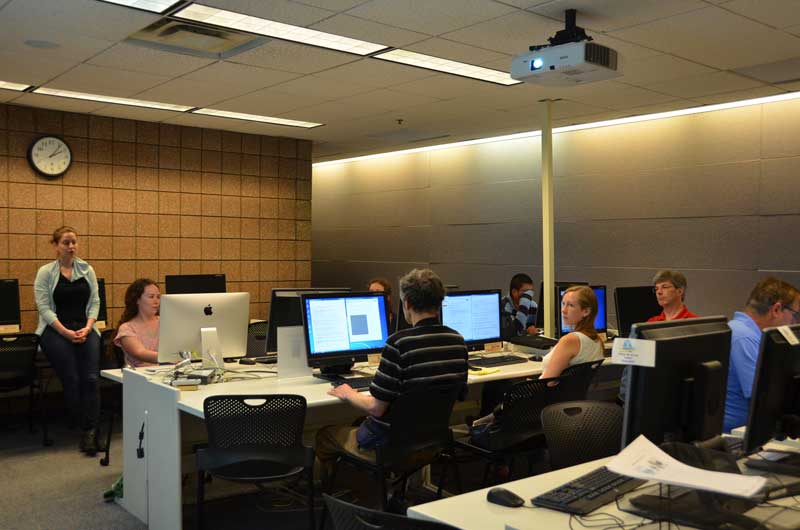 Alicia Welden (Geva group) and Blair Winograd (Geva group) led an interactive session guiding participants through their student tutorial of Mathematica. They use this in their introductory physical chemistry course to build the skills necessary to design demos of course concepts. For more info visit: http://umich.edu/~pchem/compute-to-learn.html.
Alicia Welden (Geva group) and Blair Winograd (Geva group) led an interactive session guiding participants through their student tutorial of Mathematica. They use this in their introductory physical chemistry course to build the skills necessary to design demos of course concepts. For more info visit: http://umich.edu/~pchem/compute-to-learn.html.
Plenary Presentation
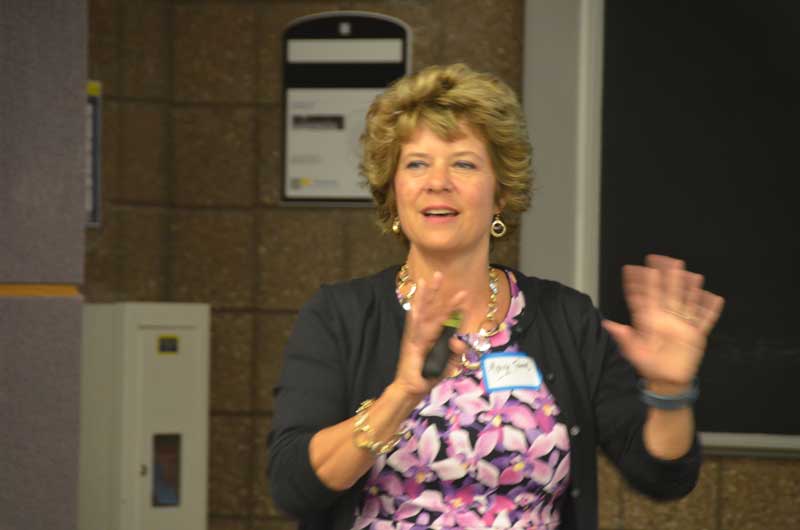 Professor Marcy Towns (Purdue University) gave our keynote address to close the day. She told us about her work in the area of faculty and student goals for laboratory. Her work has found dramatic differences in the emotional and intellectual goals between this two set of involved individuals. Moving forward this work should improve instruction, influence curricular goals, and nucleate conversation around higher level goals like critical thinking and experimental design.
Professor Marcy Towns (Purdue University) gave our keynote address to close the day. She told us about her work in the area of faculty and student goals for laboratory. Her work has found dramatic differences in the emotional and intellectual goals between this two set of involved individuals. Moving forward this work should improve instruction, influence curricular goals, and nucleate conversation around higher level goals like critical thinking and experimental design.
Two publications about this work: J. Chem. Educ., 2015, 92 (12), pp 2031–2037 & J. Chem. Educ., 2013, 90 (3), pp 281–288.s

